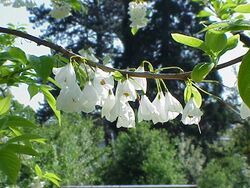Biology:Halesia carolina
| Halesia carolina | |
|---|---|

| |
| Scientific classification | |
| Kingdom: | Plantae |
| Clade: | Tracheophytes |
| Clade: | Angiosperms |
| Clade: | Eudicots |
| Clade: | Asterids |
| Order: | Ericales |
| Family: | Styracaceae |
| Genus: | Halesia |
| Species: | H. carolina
|
| Binomial name | |
| Halesia carolina | |
| Synonyms[2] | |
| |
Halesia carolina, commonly called Carolina silverbells or little silverbells, is a species of flowering plant in the family Styracaceae, native to the southeastern United States.
Description
It is a vigorous, fast-growing deciduous shrub or tree growing to 8 m (26 ft) tall by 10 m (33 ft) broad, bearing masses of pendent, bell-shaped white flowers which appear in spring before the leaves. The flowers are followed by green, four-winged fruit. The leaves turn yellow in autumn.[3][4]
Range
The range of little silverbells is very restricted. It is principally in the panhandle of Florida, with isolated smaller outlier populations in South Carolina, Georgia, Alabama, Mississippi. In the cited reference, this species is referred to as Halesia parviflora.[5] The "champion" Halesia carolina on the 2015 American Forests' National Register of Champion Trees is quite removed from its natural range, being situated in Roxbury, New Hampshire.[6]
Taxonomy
There is a great deal of confusion in the four-winged American silverbells. Four principal species names have been used: H. carolina, H. parviflora, H. monticola, and H. tetraptera. The taxon being described here is the one that has also been described as H. parviflora.[7] Some botanists have discarded the name H. carolina because the original material is viewed as ambiguous; others maintain that the original material is this species, so carolina is here being used instead of parviflora, since H. carolina L. has clear precedence.[8]
Cultivation
In cultivation in the United Kingdom, H. carolina Vestita Group has gained the Royal Horticultural Society's Award of Garden Merit.[9][10] It requires an acid or neutral soil, in a partially shaded position.
The fruits may be collected in late fall and early winter.[11]
References
- ↑ Botanic Gardens Conservation International (BGCI).; IUCN SSC Global Tree Specialist Group (2018). "Halesia carolina". IUCN Red List of Threatened Species 2018: e.T135952711A135956142. doi:10.2305/IUCN.UK.2018-2.RLTS.T135952711A135956142.en. https://www.iucnredlist.org/species/135952711/135956142. Retrieved 20 November 2021.
- ↑ "Halesia carolina L.". http://www.theplantlist.org/tpl1.1/record/kew-2838104. Retrieved 16 September 2015.
- ↑ RHS A-Z encyclopedia of garden plants. United Kingdom: Dorling Kindersley. 2008. p. 1136. ISBN 978-1405332965.
- ↑ "Halesia carolina". Missouribotanicalgarden.org. http://www.missouribotanicalgarden.org/gardens-gardening/your-garden/plant-finder/plant-details/kc/a440/halesia-carolina.aspx. Retrieved 2012-12-26.
- ↑ Little Jr., Elbert L. (1976). Atlas of United States Trees. 4 (Minor Eastern Hardwoods). US Government Printing Office. OCLC 3703736.
- ↑ "Carolina Silverbell (Halesia carolina)". americanforests.org. http://www.americanforests.org/bigtree/carolina-silverbell-halesia-carolina-5. Retrieved 2015-12-08.
- ↑ "International Plant Names Index: Halesia parviflora". International Plant Names Index. http://www.ipni.org/ipni/simplePlantNameSearch.do;jsessionid=762C2F2BF855D77658D23F612F9795A6?find_wholeName=halesia+parviflora&output_format=normal&query_type=by_query&back_page=query_ipni.html. Retrieved 2012-12-30.
- ↑ "International Plant Names Index: Halesia carolina". International Plant Names Index. http://www.ipni.org/ipni/simplePlantNameSearch.do;jsessionid=B3992E64ADB7A132C6BDA6F15E42A154?find_wholeName=halesia+carolina&output_format=normal&query_type=by_query&back_page=query_ipni.html. Retrieved 2012-12-31.
- ↑ "RHS Plant Selector Halesia carolina Vestita Group AGM / RHS Gardening". Apps.rhs.org.uk. https://www.rhs.org.uk/Plants/293473/Halesia-carolina-Vestita-Group/Details. Retrieved 2020-04-17.
- ↑ "AGM Plants - Ornamental". Royal Horticultural Society. July 2017. p. 43. https://www.rhs.org.uk/plants/pdfs/agm-lists/agm-ornamentals.pdf. Retrieved 3 March 2018.
- ↑ Bonner, Franklin (2008). Woody Plant Seed Manual. USDA Forest Service's Research and Development. pp. 103-113.
External links
Wikidata ☰ Q3125935 entry
 |





